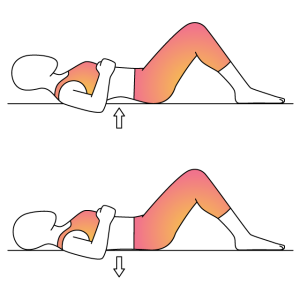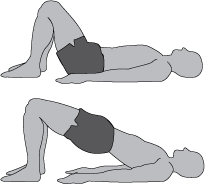Pelvic Bridge Vs. Pelvic Tilt

When a person comes into the office as either a new patient or as a wellness visit, I usually ask if they perform any type of exercise at home. Some answer no because they are too busy or do not have the equipment at home. Others will say that they go to the gym and the rest will say they try and work on exercising at home. My next question is if they know what a pelvic tilt is. If the person takes a yoga class or has had some sort of physical therapy in the past this is familiar to them. Some will go into a bridge position and rest give me a blank stare. This lead me to start thinking how many people are doing a bridge instead of a pelvic tilt.
So what is a pelvic tilt? A pelvic tilt is an exercise comprised of very subtle spinal movements that strengthen the support muscles around the low back, particularly the abdominals. They are a good preliminary exercise for those seeking low back pain relief or to help improve your posture. They can be done lying on the floor or standing with the back to a wall. For performing them on your back, lie on your back with the knees bent and the soles of the feet on the floor. This is your Neutral Spine* with the natural curve of the lumbar spine causing the low back to be slightly elevated from the floor. On an exhale, gently rock your hips towards your face. Your butt will not actually leave the floor, but you will feel your low back press into the floor. You are essentially taking the curve out of the low back. Think of the pelvis as a bowl of water. When you do the pelvic tilt, the water would be spilling towards your belly. After a few seconds, inhale and return to your neutral position. Repeat this movement 5 to 20 times.
When working on pelvic tilts you are trying to achieve a *neutral spine. Neutral spine is the natural position of the spine when all 3 curves of the spine; cervical (neck), thoracic (middle) and lumbar (lower) are present and in good alignment. This is the strongest position for the spine when we are standing or sitting.

Pelvic tilts are a basic exercise that needs to be mastered before challenging yourself with harder exercises. If keeping a pelvic tilt is difficult then performing harder exercises will cause discomfort and maybe even pain in the low back area. There is no rush into progressing with exercises. If a patient has acute low back pain, pelvic tilts are great for relieving tension in the back. Bridges would come later into the rehab protocol once the pelvic tilts technique is acquired.

A pelvic bridge is a great exercise that works on glutes, hamstrings, core muscles such as rectus abdominis and erector spinae. Bridges can be modified to increase the level of difficulty by adding a swiss ball, Bosu ball, single leg movement and other variations. At the beginning of a rehab routine we usually wait to perform any type of bridging for low back patients due to the possibility of the low back not responding well due to poor core strength. By going into a bridge, it is putting your back into extension and patients that come in with low back issues have a hard time with extension. Before going into a bridge I always make sure that the body is in a pelvic tilt so there is no extra tension in the low back. Lie face up on the floor, with your knees bent and feet flat on the ground. Keep your arms at your side with your palms down or up. Lift your hips off the ground until your knees, hips and shoulders form a straight line. Squeeze those glutes hard and keep your abs drawn in so you do not overextend your back during the exercise. Hold for three to five seconds and then bring your hips back down to the floor. Repeat for two sets of ten reps. After a few days of trying bridges and there are no residual effects then we will progress with the exercise.
If you would like to learn more about performing pelvic tilts and bridges, please call the office for a FREE CONSULTATION at 847-362-4476 with Dr. Jordan or Dr. Jade to see how we can help you!!

